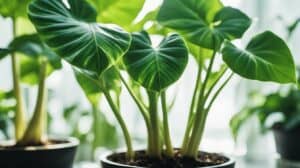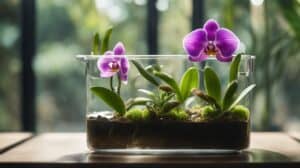The exotic Jade Vine, also known as Strongylodon macrobotrys, is a stunning flowering plant native to the Philippines.
Its vibrant blue-green flowers hang in long clusters, making it a popular choice for gardeners looking to add a unique touch to their landscape.
However, cultivating this plant can be challenging, especially for beginners.
In this article, we will provide a beginner’s guide to propagation, detailing the steps needed to successfully grow and maintain a Jade Vine.

Propagation is the process of reproducing plants from a parent plant, either through seeds or cuttings.
For the Jade Vine, propagation through cuttings is the most common method. However, it requires specific conditions and techniques to ensure success.
This guide will cover the necessary steps to take when propagating a Jade Vine, including selecting the right cutting, preparing the soil, and providing the proper care and maintenance.
Whether you’re a seasoned gardener or a beginner looking to try something new, cultivating a Jade Vine can be a rewarding experience.
With this guide, you’ll have the knowledge and tools needed to propagate and care for this exotic plant, bringing its vibrant beauty to your own garden.
Understanding the Jade Vine
Origins and Characteristics
The Jade Vine (Strongylodon macrobotrys) is a rare and exotic flowering plant that is native to the Philippines.
It is a member of the legume family and is known for its stunning blue-green flowers that hang in long clusters.
The flowers are pollinated by bats and are a vital source of food for them.
The Jade Vine is a slow-growing plant that can reach up to 70 feet in length. It has long, slender stems that are covered in glossy green leaves.
The plant requires a warm and humid environment to thrive and is typically grown in greenhouses or conservatories.
Importance of Propagating Jade Vine
The Jade Vine is a highly sought-after plant due to its unique and striking appearance.
It is often used in botanical gardens and as a decorative plant in private gardens.
However, due to its rarity and slow growth rate, it can be difficult to obtain.
Propagating the Jade Vine is an important way to ensure its survival and availability.
By growing new plants from cuttings or seeds, more people can enjoy the beauty of this rare plant.
Additionally, propagating the Jade Vine can help to preserve its genetic diversity and prevent the loss of unique traits.
Overall, understanding the Jade Vine is key to successfully propagating and caring for this exotic plant.
By providing the right environment and using proper propagation techniques, anyone can enjoy the beauty of the Jade Vine in their own garden or greenhouse.
Propagation Techniques

Jade Vine is a beautiful and exotic plant that can add a unique touch to any garden.
Propagation of the Jade Vine can be done through various methods, including seed germination, stem cuttings, and layering methods.
Seed Germination
Seed germination is a popular method of propagating Jade Vine.
The seeds of the Jade Vine are large and flat, and they should be planted in a well-draining soil mix.
The seeds should be planted about 1 inch deep and kept moist.
Germination can take several weeks, and it is important to keep the soil moist during this time.
Stem Cuttings
Stem cuttings are another effective method of propagating Jade Vine.
Cuttings should be taken from the mature stems of the plant and should be about 6 inches in length.
The cuttings should be planted in a well-draining soil mix and kept moist until roots form.
Once the roots have formed, the plant can be transplanted to a larger pot or directly into the ground.
Layering Methods
Layering methods are a great way to propagate Jade Vine as well.
This method involves bending a branch of the plant down to the ground and covering it with soil.
Once the branch has rooted, it can be cut away from the parent plant and transplanted to a new location.
This method is especially useful for propagating larger plants.
Overall, there are several effective methods of propagating Jade Vine.
By using these techniques, gardeners can enjoy the beauty of this exotic plant in their own gardens.
Caring for Your Jade Vine

Once you have successfully propagated your jade vine, it’s important to care for it properly to ensure its health and longevity.
Here are some tips on how to care for your jade vine:
Soil and Fertilizer Requirements
Jade vines prefer well-draining soil that is rich in organic matter. A mixture of peat moss, perlite, and vermiculite works well.
Fertilize your jade vine every two weeks during the growing season with a balanced fertilizer that is high in nitrogen.
Avoid over-fertilizing, as this can lead to excessive leaf growth at the expense of flowers.
Watering and Sunlight Needs
Jade vines need to be watered regularly, but be careful not to overwater them. Allow the top inch of soil to dry out before watering again.
Jade vines prefer bright, indirect sunlight, but can also tolerate some shade. Too much direct sunlight can scorch the leaves.
Pruning and Training
Jade vines can grow up to 30 feet long, so pruning and training are important to keep them under control.
Prune your jade vine in the spring to remove any dead or damaged wood. You can also prune it to shape it or to encourage branching.
To train your jade vine to grow in a certain direction, use stakes or trellises.
By following these simple tips, you can ensure that your jade vine thrives and produces beautiful, exotic flowers for years to come.
Troubleshooting Common Issues

Pest and Disease Management
Jade vines are generally hardy plants, but they can still fall prey to pests and diseases. Here are some common issues and how to address them:
-
Spider Mites: These tiny pests can cause yellowing leaves and webbing on the plant.
To get rid of them, spray the plant with a mixture of water and dish soap. Alternatively, you can use neem oil or insecticidal soap.
-
Mealybugs: These white, cottony pests can be found on the stems and leaves of the plant.
To get rid of them, use a cotton swab dipped in rubbing alcohol to wipe them off. You can also use insecticidal soap.
-
Fungal Diseases: Jade vines can be susceptible to fungal diseases, especially if they are overwatered.
To prevent these diseases, make sure the plant has good drainage and avoid getting water on the leaves.
If you notice any signs of fungal disease, such as wilting or brown spots on the leaves, remove the affected leaves and treat the plant with a fungicide.
Addressing Growth Problems
If your jade vine is not growing as well as you would like, there are a few things you can do:
-
Light: Jade vines need bright, indirect light to grow well.
If your plant is not getting enough light, move it to a brighter spot or consider using artificial grow lights.
-
Watering: Overwatering can cause the plant to rot, while underwatering can cause the leaves to wilt.
Make sure the plant is getting enough water, but not too much. Water when the top inch of soil is dry.
-
Nutrients: Jade vines need regular fertilization to grow well. Use a balanced fertilizer every 2-3 weeks during the growing season.
By following these tips, you can keep your jade vine healthy and thriving.
Frequently Asked Questions

What are the ideal conditions for germinating jade vine seeds?
Jade vine seeds require warm and moist conditions for germination. The ideal temperature range for germination is between 75-85°F (24-29°C).
The seeds should be planted in a well-draining soil mix and kept consistently moist, but not waterlogged.
It is recommended to cover the container with plastic wrap or a clear plastic dome to create a humid environment.
How often should you water a young jade vine plant?
Young jade vine plants should be watered regularly to keep the soil consistently moist, but not waterlogged.
It is important to avoid letting the soil dry out completely, as this can cause stress to the plant.
The frequency of watering will depend on the specific growing conditions, such as temperature and humidity.
What kind of support structure is best for a growing jade vine?
Jade vines are climbing plants that require support as they grow. A sturdy trellis or support structure made of bamboo or metal is recommended.
The support structure should be placed in the pot or planting area before the plant is added to avoid damaging the roots.
Are there any specific soil requirements for jade vine cultivation?
Jade vines prefer a well-draining soil mix that is rich in organic matter. A mix of peat moss, perlite, and vermiculite is recommended.
The soil pH should be slightly acidic, between 5.5 and 6.5.
What steps should be taken to ensure successful rooting from a jade vine cutting?
Jade vine cuttings should be taken from healthy, mature plants in the spring or summer.
The cutting should be approximately 6-8 inches long and taken from a stem that is not flowering.
The bottom of the cutting should be dipped in rooting hormone and planted in a well-draining soil mix.
The cutting should be kept moist and placed in a warm, bright location with indirect sunlight.
How can you tell if a jade vine plant is healthy?
A healthy jade vine plant will have bright green leaves and stems, and should be actively growing.
The plant should not have any signs of pests or disease, such as yellowing leaves or brown spots.
It is important to regularly inspect the plant for any signs of stress or damage, and to address any issues promptly to ensure the plant remains healthy.













